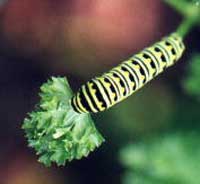 |
| Bob Lollo© |
| Parsleyworm In Action |
How To Use This Problems Section
The chart is organized to give you a quick and dirty summary of the possible symptoms that you may encounter. Those problem causes for which we have full files will be linked to those files. Those causes with no link will have a paragraph below the chart helping you deal with that particular problem.
| Problems of Parsley | |
|---|---|
| Symptoms | Probable Cause |
| Holes Eaten in Leaves | Cabbage Loopers |
| Crowns Tunneled, Leaves Damaged | Carrot Weevils |
| Leaves Eaten to Stems | Parsleyworms |
| Plants Rotted or Stunted | Carrot Rust Fly |
| Plants Stunted, Leaves Yellowed | Nematodes |
| Leaves Stippled, Yellowed | Spider Mites |
| Large Ragged Holes in Leaves | Snails and Slugs |
| Seedlings Chewed or Eaten Entirely | Rabbits |
| Crowns and Roots Mushy | Crown Rot |
| Small Yellow Specks on Leaves | Septoria Leaf Spot |
Small Yellow Specks on Leaves are Caused by Septoria Leaf Spot
The leaf spots of septoria begin as small yellow specks, which later enlarge, becoming tan to brown with a yellow border. They can be either circular or irregular in shape, and often have a black dot in the center. Spray healthy foliage with general garden fungicide to protect it from infection. If that doesn't halt the spread of the problem, pull up the infected plants. Try planting a disease resistant parsley variety, such as ‘Paramount.’
Crowns and Roots Mushy Due to Crown Rot
Crown and root rot, caused by soil-dwelling bacteria and fungi, occasionally attack parsley. The disease initially attacks a few spots on the crown where the roots join the stems at the soil line. Then it spreads to the entire crown, turning it into a malodorous mush. New shoots may fail to emerge in the spring. If the plant is already in leaf, the lower leaves discolor and the young shoots begin to wilt. The roots are blackened, rotten and covered with white fungal threads. The whole plant dies in a few days.
Remove and discard any infected plants and the soil of the rootball in the trash. Avoid replanting parsley in the same place for awhile. Thoroughly loosen the soil around the plants to encourage it to dry out, which retards fungus growth. If you catch the disease early, spray uninfected foliage with general garden fungicide containing sulfur. Wash it well before using it in the kitchen.
Since this disease is most likely to occur in a late winter thaw when dead leaves decompose on the ground and harbor bacteria and fungi which spread to healthy plants, treat your parsley plants as annuals and pull them up in the fall of their first season.
Click here for more information about Dealing with Fungal Disease

